Abstract
This modeling study focused on the hydrological and water quality effects of controlled drainage (CD) when operated using a subsurface drainage system in an agricultural field in the Wielkopolska region. The DRAINMOD hydrologic model was well calibrated and validated in an experimental field. This model was used in the performance of CD and free drainage (FD) combinations (108 and 27, respectively) in a near-future climate change scenario. The objective was to understand the potential of CD on the groundwater table (GWT), drainage outflow, surface runoff, and nitrogen and phosphorus reduction under projected climate conditions in Poland during the 21st century with shared socioeconomic pathway SSP370. The results indicated that the earliest start of CD practice is the most effective in increasing GWT. Compared to current climatic conditions, when applying CD on 1 March in the near future, with an initial GWT of 60 and 80 cm b.s.l. in wet years, drainage outflows will increase by 33% and 80% for the GFDL model, by 30% and 40% for the MPI model, and by 17% and 23% for the UKESM model. Comparing the surface runoff values obtained to current climate conditions, the MPI, GFDL, and UKESM models predict a significant increase in surface runoff in the near future, which is due to the predicted increase in precipitation. The annual NO3–N reduction was by 22, 19, and 15 kg per hectare for wet, normal, and dry years, respectively, in the near future. Among the climate scenarios, the UKESM model predicted higher NO3–N and PO4 leaching values compared to the MPI and GFDL models.
1. Introduction
One of the fundamental components of protecting surface water in most European Union countries is the conducting of a realistic assessment of the quantity of nitrogen compounds and other nutrients that are released from agricultural catchments [1,2,3]. This evaluation is critical because it determines the fate of the water, particularly when it is at a high risk of eutrophication, such as in the case of the Baltic Sea [4]. Its watershed covers 14 countries, including Poland, which is situated on the coastline and encompasses approximately 18% of the area. Nutrient loads originating from Poland are carried by the Vistula and Oder rivers, as well as the nine rivers of the Przymorze, contributing an estimated 30% of the total nitrogen load introduced into the basin [5]. This is mainly due to the fact that 59.8% of Poland’s land is used for agriculture, with 72.4% of it being arable land where crops are accompanied by the intensive application of fertilizers, particularly mineral or chemical nitrogen fertilizers [6]. Considering the additional intensive livestock breeding in Poland, it is assumed that agriculture is the primary economic sector responsible for introducing the largest amount of nutrients into surface waters [7].
The intensification of land use and changes in land and water management in agriculturally used areas necessitates the exploration of new adaptive solutions to realize the potential of artificial agricultural subsurface drainage systems [8,9,10,11]. Presently, depending on the region, they are primarily used for two purposes: to enhance and facilitate the management of soil water associated with salinity and waterlogging and to unilaterally remove excess water, thereby improving soil aeration and field access [12]. As such, tile drainage has been identified as the primary pathway for delivering nutrients and other pollutants to surface waters, which is a significant factor given that an estimated 34% of total agricultural land in northwest Europe is artificially drained. Consequently, reducing the leaching of pollutants from agricultural land into drainage systems could assist in mitigating pollution from agriculture [13]. Therefore, reducing losses from the primary sources of nutrients and their mobilization by enhancing nutrient use efficiency is necessary, and the field scale appears to be an appropriate level to assess this progress [14].
One solution to this issue is CD, which is utilized to decrease the amount of drainage outflow at the scale of the drainage facility, thus reducing the quantity of N and P loads discharged. Annual reported reductions in discharge have ranged from 7% to 68%, while reductions in NO3–N loadings have ranged from −8% to 63% in the USA. However, these studies analyzed the effects of CD on P loading and have reported mixed results, with changes in total P (TP) loading ranging from no effect to 77% reductions [15,16,17]. Helmers et al. [18] demonstrated that CD led to reductions in drainage volume by 28%, 33%, and 52% under wet, normal, and dry precipitation scenarios, respectively. Additionally, Wang et al. [19] showed a meta-analysis that revealed that CD reduced subsurface drainage volume by approximately 30% for dryland crops. Studies conducted in European countries indicated varying degrees of reduction in drainage volume, ranging from 37% in Denmark to 95% in Sweden; moreover, reductions in nitrate-N were observed, from 36% in Denmark to 100% in Italy. Regarding TP reduction, the percentage of reduction varied, with values ranging from 43% to a range of 56–95% [20,21,22]. Taking into account the expected effects of climate change and local physical, geographical, and climatic conditions, environmental and technical solutions are being developed using drainage mitigation measures [23]. These solutions should be able to accommodate future climate changes and agricultural land use, with the aim of achieving crop production goals while minimizing environmental impacts. By implementing effective adaptation measures together with appropriate agro-technical measures, integrated solutions for water management in drained areas can be developed [24].
Drainage systems are typically designed with a lifespan of more than thirty years, making them a significant long-term investment. Consequently, it is crucial to conduct research on the potential impact of projected climate change on the performance of agricultural and drainage water management systems [25,26]. Simulation modeling of hydrological changes is the prevailing approach employed to evaluate how climate change could affect the efficacy of future adaptation strategies [27]. While numerous field campaigns have been conducted to investigate the effects of CD, challenges arise when attempting to test diverse scenarios involving meteorological conditions and hydrological linkages [17,28]. Models offer a valuable means of assessing the effectiveness of various water management strategies in both present and future climate scenarios [29,30,31]. Abdelbaki [32] indicated that the implementation of CD had a minimal effect on subsurface drainage, resulting in a reduction of less than 15% in the outflows during both historic and future periods. Similarly, CD demonstrated consistent changes in nitrogen losses in the drainage outflows, with a slight reduction projected for the future. The CD led to an average decrease of 4.42 kg N ha−1 yr−1, equivalent to 17.25% during the historic period, and a further reduction of 7.25 kg N ha−1 yr−1, corresponding to 25.75%, during the future period. Pease et al. [33] noticed that CD exhibited enhanced efficacy during summer, with reductions in subsurface drainage outflow increasing to 42.7% for the Representative Concentration Pathway (RCP) 4.5 emission scenario and 81.8% for RCP 8.5 under late-century climate conditions. Such evidence of the advantages of implementing CD practice in current climate conditions will continue to be applicable under projected future climate scenarios. Sojka et al. [30], who conducted simulations on the effects of CD, using RCP 4.5, observed a decreased duration of the GWT above the drainage depth in future projections. Consequently, this led to a reduced impact of CD on GWT and drainage outflow. According to Salla et al. [31], when CD is applied in future climate scenarios, it is projected to significantly impact the GWT, leading to an average increase of 1–4 cm compared to historical data. It achieves this by reducing annual drain discharge by approximately 41.3 to 46.2 mm and 22.4 to 26.1 mm in RCP 8.5, as well as 41.3 to 43.2 mm and 21.0 to 24.8 mm in RCP 2.6, respectively. These results highlight the relevance and viability of CD as an effective method for mitigating drainage outflow, particularly in milder winter conditions in the future.
The purpose of this study was to determine the effect of CD on the GWT, drainage outflow, and N and P losses from agricultural fields in Greater Poland. Simulations have been carried out, assuming changes in temperature and precipitation in line with the Inter-Sectoral Impact Model Intercomparison Project (ISIMIP) simulations, in particular the third round of ISIMIP3b, as part of the international Coupled Model Intercomparison Project 6 (CMIP6). It focuses on regional scale changes in agriculture for three models (Geophysical Fluid Dynamics Laboratory (GFDL), Max Planck Institute Earth Model (MPI), and UK Earth System Model (UKESM)) for predicting the impact of future climate changes. Our study uses the SSP370 scenario with an additional radiative forcing of 7 W m−2 by the year 2100. This scenario is in the upper-middle part of the full range of scenarios and has been newly introduced, closing the gap between RCP6.0 and RCP8.5. To know the seasonal effects of CD, it is necessary to study long-term simulations with future climate predictions and assess the change in the near future. Through modeling the time period 2021–2050, this study considers varying parameters, including different weather conditions, initial GWT conditions, and the implementation of CD solutions with specific drain blocking dates. The objective is to analyze the outcomes and implications of employing CD in order to mitigate the impacts of climate change on the amount of drainage water and crop cultivation. Furthermore, the study aims to investigate the feasibility of achieving favorable surface water quality by reducing nutrient loading from agricultural land. The results obtained from this research will provide valuable insights into the potential contributions and effectiveness of CD in addressing the challenges posed by climate change in relation to crop production and water quality management.
2. Materials and Methods
2.1. Study Area Description
The study site is a drainage field of arable land located in Ostrowo Szlacheckie (Figure 1) in the central-western part of Greater Poland, Poland (N 52°21′38.5″ and E 17°36′34.2″). In late 2018, modifications were made to drainage section number 42, which is divided into four subsections. Two of these subsections were equipped with CD, while the remaining two were maintained as FD. The study area is flat (average slope of less than 1.0%), and the soils within it, based on field and laboratory studies, were classified as Gleyic Luvisols [34]. The spacing of drains was 14 m, while the tile depth was 0.9–1.0 m. The basic soil properties of the analyzed study area are shown in Table 1.
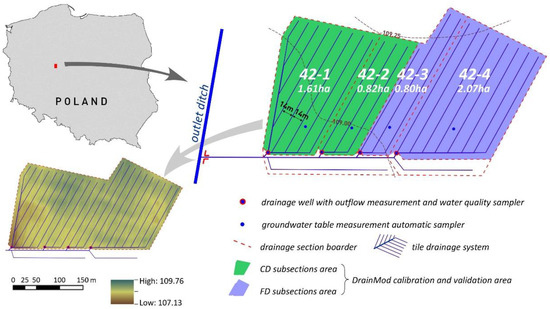
Figure 1.
The drainage experimental field in Ostrowo Szlacheckie.

Table 1.
Input model parameters for soil layers of drainage section No. 42.
During the CD experiment in 2019–2020, GWT was recorded hourly and separately from the CD area and the FD area using Solinst LTC Leveloggers and Barologger Edge. Also, the depths of the GWT were observed manually (approximately once a week) using the study plot. Hourly meteorological data were gathered from the experiment meteorological station at Sokołowo, next to the Ostrowo Szlacheckie field. Daily data were used for the measured precipitation (P) and minimum and maximum air temperature (T). These data from March–September 2019–2020 were used to calibrate and validate the model.
A comprehensive description of the study area, the field measurement equipment installed, and details of the fieldwork and laboratory analyses carried out can be found in the publication by Kęsicka et al. [34].
The main forms of biogenic compounds were determined in water samples from drainage outflows. Table 2 outlines the standard methods employed to determine various parameters, including nitrite nitrogen and orthophosphate (V).

Table 2.
Nutrient concentrations determined in drainage water samples from the facility.
2.2. Climate Data
The daily maximum and minimum air temperature, as well as precipitation data, were obtained from the ISIMIP Repository for this study. A selection of three global climate models (GCMs) (Table 3) was made for a one-time horizon to the near future (2021–2050). The future climate projections were based on the SSP370 scenario for the Poznań meteorological station (45 km from the field) [37]. This particular scenario, known as “regional rivalry”, assumes an expected radiative forcing level of 7 W m−2 by 2100, with a focus on regional dynamics, while global issues are given less priority [38]. The data used in this study were bias-corrected at a resolution of 0.5° grid cell [37]. The average values of these parameters were obtained from data from grid cells around Poznań and then compared to the simulated values of the historical period (1971–2000) and the observed values from the Institute of Meteorology and Water Management–National Research Institute (IMGW-PIB).

Table 3.
Climate change projection models included in this study.
Figure 2 shows the temporal development of variables, describing the climate conditions, especially historical precipitation during the years 1971–2000, which were used to choose models for the simulations. The average annual precipitation recorded for the Poznań meteorological station from the analyzed multi-year period is 507 mm. For the selected GFDL, MPI, and UKESM models, it is 582, 599, and 583 mm, respectively.
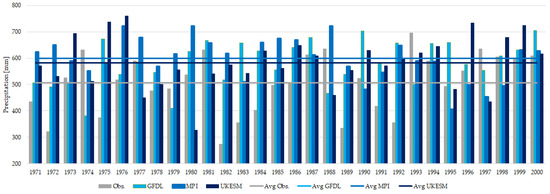
Figure 2.
Annual mean precipitation for the Poznań meteorological station and historical projected data are presented for GFDl, MPI, and UKESM climate change models for 1971–2000.
Figure 3 shows the temporal variation of precipitation in the near future of 2021–2050 for the SSP370 scenario for Poznań. The annual mean value of precipitation in the used future scenario is 651, 626, and 620 mm for the GFDL, MPI, and UKESM models, respectively.
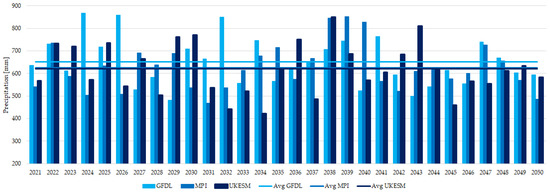
Figure 3.
Annual mean precipitation projected data are presented for GFDl, MPI, and UKESM climate change models for 2021–2050.
2.3. DRAINMOD
The DRAINMOD model is an open-source, deterministic, hydrological model that allows for the prediction of changes in the water balance of agricultural land under different drainage systems and practice scenarios. The model uses five groups of input data such as drainage system characteristics, soil properties data, crop information, weather data, and management data (irrigation schedule, fertilizer application, rates, and GWT control strategies). These input data parameters are used by the DRAINMOD model to simulate hydrological processes, water movement, and nutrient transport in agricultural subsurface drainage systems. The model provides output data, such as drainage outflow, water table depth, crop water use, and nutrient losses, which can be used to evaluate the performance and impact of the drainage system and inform management decisions. The model uses soil hydraulic parameters according to Mualem [39] and Van Genuchten [40]. Drainage outflow in most cases is calculated from the Hooghoudt equation; however, when the water table reaches the surface and the land surface is further flooded, the outflow rate is calculated using the Kirkham equation [41]. Surface runoff is calculated when the user-defined soil storage capacity is the difference between rainfall and infiltration rate, using the Green–Ampt equation [42]. This model uses the Thornthwaite method to calculate daily evapotranspiration from maximum and minimum temperatures [43].
2.4. Model Setup
The simulations were performed for different scenarios for the periods from 1 March to 30 September. A total of 108 and 27 modeling scenarios (Figure 4) were performed for the assumed input parameters for CD and FD, respectively, to test the effectiveness of the practices used. The following modeling input parameters were established: different meteorological conditions (wet, normal, and dry years due to precipitation), initial GWT on 1 March, simulation start date, three different variants of 0.40, 0.60, and 0.80 m below surface level (b.s.l.), and CD practice start dates of 1 March, 15 March, 1 April, and 15 April. All analyses were conducted for a drain spacing of 14 m. The drainage coefficient and maximum surface storage were set at 0.011 cm and 0.005 m, respectively. Kirkham’s depth for the flow into the drains was set at 0.5 cm, while the drainage coefficient was set at 1.4 cm day−1. The depth of the impervious layer was 4.00 m. We originated DRAINMOD soil-related parameters based on soil properties (Table 1). In addition, the soil tool package provided in DRAINMOD was used to determine the parameters of the Green–Ampt infiltration model, the relationship between drainage volume and upflux, and water table depth. The prepared DRAINMOD model, in accordance with the procedure indicated by Skaggs et al. [44], was calibrated and validated using field measurement data from 2019 and 2020, respectively. Multiple rounds of adjusting input parameters were carried out to achieve an acceptable level of agreement and minimize differences between observed and modeled GWT data. Model performance analysis was performed using statistical indicators during the calibration and validation procedure, such as the root mean square error (RMSE), residual weight ratio (CRM), consistency index (d), and model efficiency factor (EF) [45,46]:
where n is the total number of observations, Oi is the observed value of the ith observation, Pi is the predicted value of the ith observation, and O is the mean of the observed values (i = 1 to n).
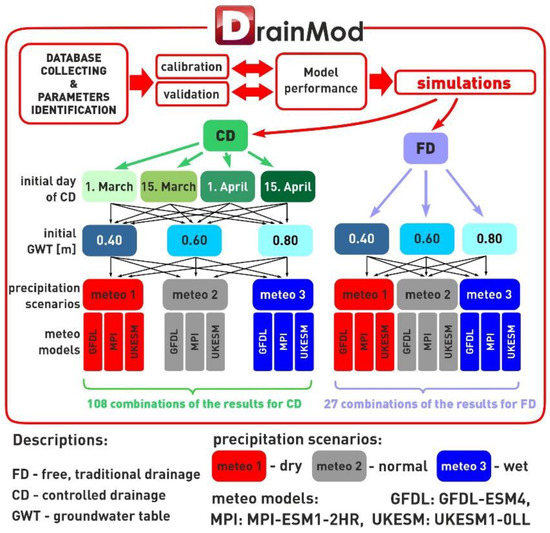
Figure 4.
Modeling procedure in DRAINMOD.
2.5. Processing Output Data
DRAINMOD modeled daily values for the output variables. The results were examined by dividing the years 2021–2050 into three groups of years (wet, normal, and dry) and into three consecutive variants using climate change models (GFDL, MPI, and UKESM). These variants were used to combine data (GWT, subsurface drainage outflows, surface runoff, and loads of nutrients) to indicate the climatic and hydrologic conditions of each combination of the results for CD. The statistical significance between each drainage and initial GWT variant for dry, wet, and normal years was analyzed using ANOVA and Tukey’s HSD significance test with α = 0.05. The Statistica 13.3 program (TIBCO Software Inc., Palo Alto, CA, USA) was used for calculations.
3. Results
3.1. Quality of Model and Data
For the configured DRAINMOD model, the obtained calibration and validation process RMSE values were 0.054 m and 0.069 m, while, for CRM, they were 2.1% and 2.9%, respectively. The d and EF values for calibration were 0.960 and 0.961; for validation, the value was 0.947. The indicated model quality characteristics obtained for both calibration and validation indicate very high agreement between measured and modeled GWT. The prepared DRAINMOD model can be used to simulate the impact of different CD scenarios for the projected climate change on the dynamics of the GWT and drainage outflow of a drainage facility.
Using daily historically measured and predicted precipitation data ranked from lowest to highest, a data fit analysis was performed for the selected models. Figure 5 shows the basic quality statistics for selected GFDL, MPI, and UKESM models of SD < 1, RMSE < 0.5, and r > 0.95.
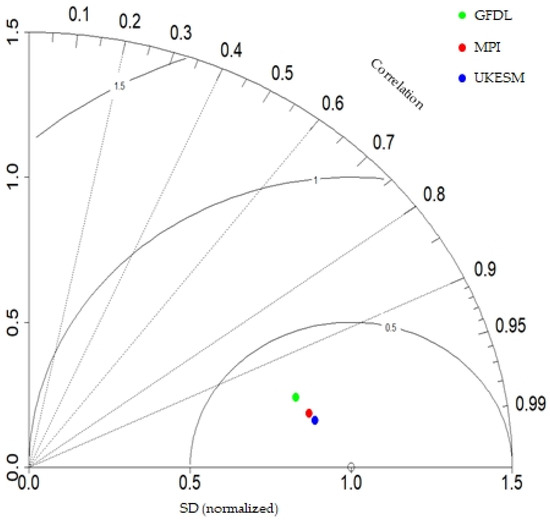
Figure 5.
Taylor graph showing a statistical comparison between observations of GFDL, MPI, and UKESM model estimates of global future climate projections of precipitation for Poznań.
3.2. Effect of CD on GWT
Changes in GWT due to projected climate change were more evident in the results obtained for the GFDL and UKESM models (Table 4). In their case, the start of CD in the 1 March deadline indicated the shallowest GWT in the analyzed period. Based on the GFDL model data, GWT can increase by 27–41, 12–33, and 11–31 cm on average, as well as, for the UKESM model, by 14–34, 17–33, and 8–29 cm in wet, normal, and dry years, respectively. After this date, in the March–April period, the GWT decreased to the depth indicated for FD modeling. In CD simulations based on MPI model data, the practice start dates of 1 March and 15 March resulted in the GWT being maintained at similar depths in the adopted modeling variants. Based on the MPI model data for the start of the CD dates of 1 March and 15 March, similar results were obtained for the GWT, which can, on average, increase by 23–39, 19–36, and 16–35 cm in wet, normal, and dry years, respectively. Later start dates for withholding outflow resulted in a flattening of the water table to the FD practice.

Table 4.
Average GWT for wet, normal, and dry years for FD and CD practice of different initial GWT variants for GFDL, MPI, and UKESM models.
Starting CD practice on 1 March increases the number of days with GWT above the level of laying drains. For wet years, the number of days for the initial depth of 40 cm b.s.l. was highest at 67, 64, and 60 days for the GFDL, MPI, and UKESM models, respectively (Figure 6A). Also, for a depth of 60 cm b.s.l., it was 63, 60, and 53 days; for a depth of 80 cm b.s.l., it was less than 54 days for the GFDL, MPI, and UKESM models, respectively. The timing of the start of CD practice in normal years indicated a reduction in the number of days. Depending on the initial depth of groundwater when withholding runoff on the 1 March deadline, a range of 37–58 days was indicated for the GFDL model; meanwhile, it was 44–61 for MPI and 45–60 for UKESM (Figure 6B). For dry years, the number of days was 33–54 for GFDL, 40–59 for MPI, and 32–53 for UKESM (Figure 6C). The start of CD practice on 15 March indicates the following time ranges for the GFDL model: 39–41 days, 25–32 days, and 22–28 days for wet, normal and dry years, respectively. For other models including MPI (51–63 days, 44–60 days, and 39–58 days) and UKESM, it was 29–35 days, 32–38 days, and 21–28 days, for wet, normal, and dry years, respectively.
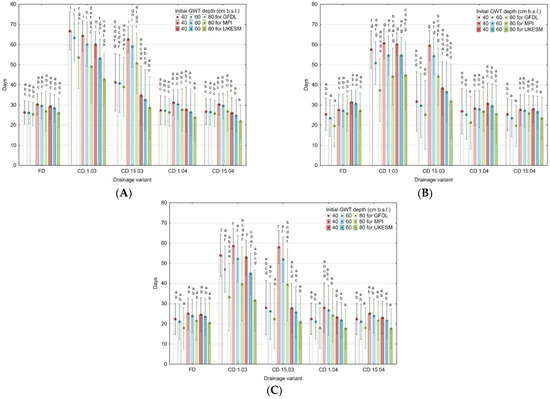
Figure 6.
Number of GWT days above the depth of the drainage network under FD and different variants of CD practice for wet (A), normal (B), and dry (C) years for GFDL, MPI, and UKESM climate change models (bar charts show the average values and standard deviation (SD); different letters indicate significant differences (p ≤ 0.05) between variants of drainage according to the Tukey test).
3.3. Effect of CD on Subsurface Drainage Outflows
The average sum of drainage outflows for the start of the CD on 1 March for the variants of all three rainfall scenarios and the adopted climate change models GFDL, MPI, and UKESM is the lowest value. The obtained modeling results indicate homogeneous groups a and b (Table 5). In addition, for the withholding of outflows on 15 March, for the MPI model, lower outflows were again obtained, indicated for homogeneous groups a–d. Starting CD practice after 1 April and 15 April, the adopted year scenarios do not indicate significant differences for wet, normal, and dry years and are similar to FD results.

Table 5.
Average subsurface drainage outflows for wet, normal, and dry years for FD and CD practices of different initial GWT variants for GFDL, MPI, and UKESM climate change models.
The lowest number of days with drainage runoff was indicated when the practice of stopping runoff began on 1 March for all modeling scenarios (Figure 7). In wet years, for the adopted scenarios, the number of days with drainage outflow is 17–19, 18–21 and 15 for the GFDL, MPI, and UKESM models, respectively. In normal years, it is 12–14, 15–17, and 16–18 days for the GFDL, MPI, and UKESM models, respectively. Similarly, in dry years, it is 12–14, 13–15, and 11–13 days for the GFDL, MPI, and UKESM models, respectively.
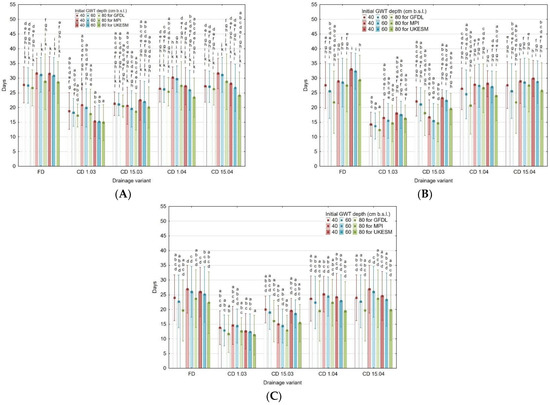
Figure 7.
Number of days with drainage outflow for FD and different variants of CD practice under wet (A), normal (B), and dry (C) years for GFDL, MPI, and UKESM climate change models (bar charts show the average values and SD; different letters indicate significant differences (p ≤ 0.05) between variants of drainage according to the Tukey test).
The greatest reduction in outflows was obtained at the 1 March start date of the CD practice for all assumed modeling scenarios (Figure 8). Regardless of the assumed initial GWT in wet, normal, and dry years, the reduction results obtained were 100%. Moving the date to two weeks later (15 March) yields a significant reduction for the MPI model (above 85%). At this date, the other two models indicate much lower reductions, at 10–55%. The later withholding of outflows from 1 April to 15 April indicates the lowest reductions and/or none at all. No effect was observed when outflows were blocked from 15 April onwards for the GFDL and MPI models.
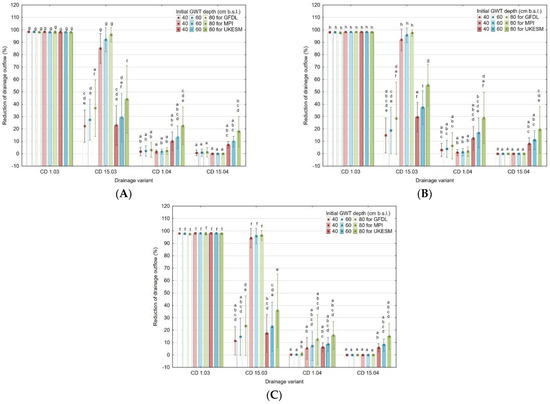
Figure 8.
Reduction in drainage outflow for different variants of CD practice under wet (A), normal (B), and dry (C) years for GFDL, MPI, and UKESM climate change models (bar charts show the average values and SD; different letters indicate significant differences (p ≤ 0.05) between variants of drainage according to the Tukey test).
3.4. Effect of CD on Surface Runoff
The highest average values of surface runoff are shown for the GFDL model for wet years with the 1 March CD start date (above 30 mm) (Figure 9). In most scenarios, for each initial GWT and different year variant, the results obtained are similar regardless of the model of predicted climate change. For normal years, the GFDL and UKESM models for all modeling scenarios indicate the same surface runoff value of 25 mm, except for the 1 March date. In dry years, significantly lower values of surface runoff were obtained, with identical results for FD and CD started on 1 April and 15 April for all scenarios for each model.
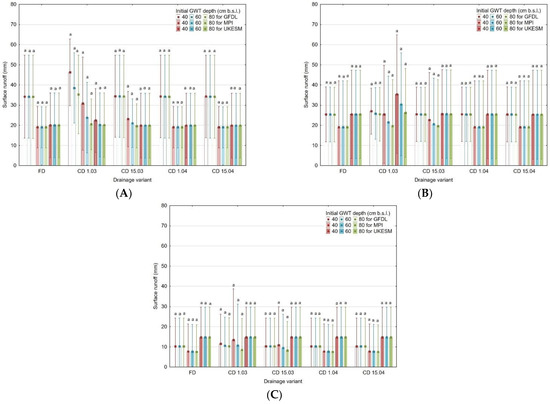
Figure 9.
Surface runoff for FD and different variants of CD practice and GFDL, MPI, and UKESM climate change models under wet (A), normal (B), and dry (C) years (bar charts show the average values and SD; different letters indicate significant differences (p ≤ 0.05) between variants of drainage according to the Tukey test).
3.5. Effect of CD on Quality Drainage Outflow
The results of the analysis of the NO3–N loads carried out indicate a significant reduction in the amount of carried loads when CD began on 1 March in all scenarios for the three climate models (Table 6). This confirms the classification of this date into two homogeneous groups a and b with a range from 0.11 to 0.51 kg ha−1. Also, the lowest values of loads were shown for the 15 March date for the MPI model, with a range from 0.42 to 5.58 kg ha−1. The CD technique that started on 1 March reduced load leaching by an average of 24.34, 22.79, and 19.06 kg ha−1 compared to FD in wet years for the GFDL, MPI, and UKESM models, respectively. In contrast, in normal years, the average load was 14.33, 19.74, and 21.93 kg ha−1, and, in dry years, it was 13.36, 17.25, and 14.36 kg ha−1 for the GFDL, MPI, and UKESM models, respectively. The start of withholding outflow after the 1 April and 15 April dates did not reduce the amount of NO3–N loads leached.

Table 6.
Average NO3–N (kg ha−1) loads for wet, normal, and dry years for GFDL, MPI, and UKESM climate change models.
Holding the outflow on the date of 1 March significantly reduced the amount of PO4 load lifted from the site compared to FD. Two homogeneous groups, a and b (Table 7), were determined for each scenario, considering this date for all climate models. For the MPI model, significantly lower loads were also obtained on the 15 March date.

Table 7.
Average PO4 (kg ha−1) loads for wet, normal, and dry years for GFDL, MPI, and UKESM models.
The highest reduction close to 100% of NO3–N and PO4 loads was shown for the CD application on 1 March (Table 8) for all GFDL, MPI, and UKESM models. Also, for the MPI model, starting the withholding of outflow on 15 March shows reductions of 85% or more for wet, normal, and dry years. Starting CD practice on 1 April and 15 April shows a much lower or no reduction.

Table 8.
NO3–N and PO4 reduction for different variants of CD practice in wet, normal, and dry years for GFDL, MPI, and UKESM models.
4. Discussion
Based on the results, the analysis of withholding outflow on the drainage network for the SSP370 pathway in the near future indicates that the efficiency of using CD solutions will increase compared to the present state. Withholding outflow on 1 March allows GWT to increase by an average of 35, 23, and 21 cm for the GFDL climate change model, by 31, 28, and 25 cm for MPI, and by 24, 25, and 19 cm for UKESM in wet, normal, and dry years, respectively, compared to FD. Comparing the present climate conditions [34] to the near future using CD on 1 March, the highest increase in GWT was achieved for the GFDL and MPI models for wet years of 4 to 8% and 3 to 6%, respectively, and for initial depths of 40 and 80 cm b.s.l. Similarly, the highest increases in GWT were recorded for the MPI model on 15 March for wet, normal, and dry years, ranging from 10–19%, 7–18%, and 2–15%, respectively. These highest values refer to the initial water depth of 40 cm b.s.l. According to the UKESM model results for the CD practice started on 1 and 15 March, no significant increases or decreases of ±2% were observed. Thus, the number of days with GWT above the drainage level (>90 cm) increases. In wet years, the number of days for the initial depth of 40 cm b.s.l. was the highest, with 67, 64, and 60 days for the GFDL, MPI, and UKESM models, respectively. For a depth of 60 cm b.s.l., it was 63, 60, and 53 days, while, for 80 cm b.s.l., it was less than 54 days for the GFDL, MPI, and UKESM models, respectively. Sojka et al. [30], who simulated the impact of CD from March to September with RCP 4.5, found that blocking outflow at the 1 March date in the near-future GWT will maintain an average of 85 days regarding the drain level.
The average sum of the drainage outflows for CD started on 1 March, allowing them to be reduced, compared to FD, by 52 mm (58, 54, and 45 mm for wet years), by 44 mm (34, 47, and 52 mm for normal years), and by 35 mm (32, 41, and 34 mm for dry years) based on the results of the three models. The lowest number of days with outflow is 17–19, 18–21 and 15 days in wet years for the GFDL, MPI, and UKESM models, respectively. In normal years, it is 12–14, 15–17, and 16–18 days, and, in dry years, it is 12–14, 13–15, and 11–13 days for the GFDL, MPI, and UKESM models, respectively. Relative to the actual climate conditions given by Kęsicka et al. [34], the highest average outflow increase of 33–80% was modeled for the near future according to the GFDL model using CD on 1 March, with GWT initial depths of 60 and 80 cm b.s.l. The MPI and UKESM models showed increases of 30–40% and 7–18%, respectively, for wet years and 17–23% and 13–25%, respectively, for normal years, both with initial depths of 60 and 80 cm b.s.l. On the other hand, when the outflow was stopped on 15 March for the MPI model in all three wet, normal, and dry years, reductions of 69–79%, 85–91%, and 88–90% were obtained. Regardless of the initial GWT in wet, normal, and dry years, the resulting reductions were 100%. Moving the date to two weeks later (15 March) yields a significant reduction for the MPI model above 85%. At this date, the other two models indicate much lower reductions, at 10–55%. Stopping the outflows from 1 April to 15 April indicates the lowest reductions and/or no reductions at all. Using CD on 1 March allows for lower amounts of NO3–N in wet years (on average, 22 kg per ha), as well as 19 kg per ha in normal years and 15 kg per ha in dry years. For PO4, it is 0.9, 0.7, and 0.6 kg per ha for wet, normal, and dry years. Sojka et al. [30] indicated an average reduction in outflow at the start of CD on the 1 March at an average level of 82% and 84% in the near and far future for the drainage networks with a spacing of 7 m. However, that research has shown that there will be a decrease in outflows from the drainage network in the analyzed time period, along with an increase in precipitation in that period. Pease et al. [33] have indicated that CD efficiency was projected to increase during summer by a 42.7% and 81.8% reduction in subsurface drainage outflow for RCP 4.5 and RCP 8.5 under late-century climate conditions. According to Khalil et al. [47], the role of CD in paddy field simulations showed a significant decrease of 61% in the drainage discharge in the near future for RCP 8.5. These results further showed that there would be a 99% decrease in runoff rate in scenarios under RCP 8.5 in the near future. Other results have shown that, under future climate change conditions, the subsurface outflow will increase, along with an increasing mean yearly precipitation [48,49,50].
Selected climate change design models for precipitation showed an increase in the average value of surface runoff for the GFDL model for wet years on the 1 March CD start date (above 30 mm). For normal years, the GFDL and UKESM models for all modeling scenarios indicate the same value of 25 mm of surface runoff, except for the 1 March date. In dry years, much lower values of surface runoff were obtained. CD starting on 1 April and 15 April, for all scenarios, for each model, had identical results to FD. According to Kęsicka et al. [34], surface runoff for current climate conditions is approximately 4.4 mm, 1.0 mm, and 0.4 mm for wet, normal, and dry years, respectively. Comparing these values to the obtained results for future climate conditions, a significant increase was noted in all models. The largest increase was observed for wet years using CD on 1 March, with values ranging between 31–42 mm, 16–26 mm, and 16–18 mm for the GFDL, MPI, and UKESM models, respectively. However, the smallest increase was observed for dry years, with values ranging from 8 to 14 mm for the adopted models. When CD is applied on 15 March for wet years, there is an increase of 30 mm, 15–19 mm, and 16 mm for the GFDL, MPI, and UKESM models, respectively. Sojka et al. [30] have shown that, in the near future, outflows measure 9.5 mm on average and that, in the far future, they measure 9.0 mm on average. These values are almost five times higher than at the present time, due to the increase in rainfall intensity in the near and far future. Mehan et al. [51] indicate that the potential growth of surface runoff should be taken into account in the future. This is important because more nutrient losses have been predicted due to extreme precipitation events with surface outflow. However, Awad et al. [52] have shown that surface runoff will be reduced by 25.3% and 23.6% under RCP 4.5 and 8.5 climate scenarios, respectively. Also, Singh et al. [53] indicated that, according to the same trend, a roughly 10–21% reduction is observed in the average annual surface runoff under future climatic scenarios.
The results obtained represent CD efficiency depending on the selected time of the simulations carried out. According to the adopted SSP370 path, an increase in average rainfall for the analyzed time period is indicated. In addition, the results presented depend on the basic parameters characterizing the drainage object, including geological conditions, soil conditions, topography, drainage network parameters, as well as hydrological and meteorological conditions. The results of this simulation show the potential hydrological impact of CD on an area in central Wielkopolska under varying meteorological forces using three models from a range of possible future climate scenarios. Thus, the results should not be interpreted as a strict forecast for the future. Moreover, in the future, vegetation can start earlier due to higher temperatures.
5. Conclusions
The results of the simulations of two FD and CD methods affecting water management in a drainage facility in the near future over a period of 30 years made it possible to analyze the impact of CD on water balance and the GWT under different conditions of the predicted climate changes of the GFDL, MPI, and UKESM models. Based on the simulated scenarios, the following conclusions were made:
- The results indicated that the earliest start of CD practice is the most effective in increasing GWT. In the near future, starting CD practice on 1 March will increase the average GWT by 24–35, 23–28, and 19–25 cm for wet, normal, and dry years for selected climate change prediction models compared to the FD practice. Compared to present climate conditions, the application of CD with an initial GWT of 40 cm b.s.l. will raise water depths by 4% in the near future. In contrast, comparing the start of the CD practice to 15 March, there will be a 2% average GWT rise in the near future;
- The earliest application of CD on 1 March reduced average annual outflow by 52, 44, and 35 mm for wet, normal, and dry years, respectively. Compared to current climatic conditions, when applying CD on 1 March in the near future with an initial GWT of 60 and 80 cm b.s.l. in wet years, drainage outflows will increase by 33% and 80% for the GFDL model, by 30% and 40% for the MPI model, and by 17% and 23% for the UKESM model. These are the results of the increase in the total precipitation predicted by the models for 2021–2050;
- Comparing the surface runoff values obtained to current climate conditions, the MPI, GFDL, and UKESM models predict a significant increase in surface runoff in the near future, which is due to a predicted increase in precipitation. The GFDL model shows surface runoff above 30 mm for all scenarios in wet years. For normal years, the GFDL and UKESM models show a value of 25 mm; meanwhile, the MPI model shows 20 mm. In dry years, the models indicate lower surface runoff values of less than 15 mm;
- Annual NO3–N was reduced by 22, 19, and 15 kg per hectare for wet, normal, and dry years, respectively, in the near future. Among the climate scenarios, the UKESM model predicted higher NO3–N and PO4 leaching values compared to the MPI and GFDL models. The highest reduction close to 100% of the NO3–N and PO4 loads was shown for CD application compared to FD on 1 March due to a reduction in drainage outflow. For the 15 March CD date, individual climate models indicated much greater variability in nutrient reduction.
Author Contributions
Conceptualization, B.K., R.S. and M.K.; methodology, B.K., M.K. and R.S.; software, B.K. and M.K.; validation, B.K., M.K. and R.S.; formal analysis, B.K., M.K. and I.P.; investigation, B.K.; resources, B.K., M.K. and R.S.; data curation, B.K.; writing—original draft preparation, B.K.; writing—review and editing, M.K., R.S. and I.P.; visualization, B.K., R.S. and I.P.; supervision, R.S. and M.K.; project administration, B.K.; funding acquisition, B.K. All authors have read and agreed to the published version of the manuscript.
Funding
This research received no external funding.
Institutional Review Board Statement
Not applicable.
Informed Consent Statement
Not applicable.
Data Availability Statement
Not applicable.
Acknowledgments
This study was conducted within the project “Technological innovations and system of monitoring, forecasting and planning of irrigation and drainage for precise water management on the scale of drainage/irrigation system (INOMEL)” under the BIOSTRATEG3 program, funded by the Polish National Centre for Research and Development, contract No. BIOSTRATEG3/347837/11/NCBR/2017.
Conflicts of Interest
The authors declare no conflict of interest.
References
- Refsgaard, J.C.; Hansen, A.L.; Højberg, A.L.; Olesen, J.E.; Hashemi, F.; Wachniew, P.; Wörman, A.; Bartosova, A.; Stelljes, N.; Chubarenko, B. Spatially differentiated regulation: Can it save the Baltic Sea from excessive N-loads? Ambio 2019, 48, 1278–1289. [Google Scholar] [CrossRef]
- Noorduijn, S.L.; Refsgaard, J.C.; Petersen, R.J.; Højberg, A.L. Downscaling a national hydrological model to subgrid scale. J. Hydrol. 2021, 603, 126796. [Google Scholar] [CrossRef]
- Seidenfaden, I.K.; Sonnenborg, T.O.; Børgesen, C.D.; Trolle, D.; Olesen, J.E.; Refsgaard, J.C. Impacts of land use, climate change and hydrological model structure on nitrate fluxes: Magnitudes and uncertainties. Sci. Total Environ. 2022, 830, 154671. [Google Scholar] [CrossRef]
- Baltic Marine Environment Protection Commission (HELCOM). State of the Baltic Sea—Second HELCOM Holistic Assessment 2011–2016; Baltic Sea Environment Proceedings 155; HELCOM: Helsinki, Finland, 2018; Available online: http://stateofthebalticsea.helcom.fi/wp-content/uploads/2018/07/HELCOM_State-of-the-Baltic-Sea_Second-HELCOM-holistic-assessment-2011-2016.pdf (accessed on 7 March 2023).
- Pastuszak, M.; Igras, J. Temporal and SPATIAL Differences in Emission of Nitrogen and Phosphorus from Polish Territory to the Baltic Sea; National Marine Fisheries Research Institute: Gdynia/Puławy, Poland, 2012; p. 452.
- Statistical Yearbook of Agriculture; Statistics Poland: Warsaw, Poland, 2022. Available online: https://stat.gov.pl/obszary-tematyczne/roczniki-statystyczne/roczniki-statystyczne/rocznik-statystyczny-rolnictwa-2022,6,16.html (accessed on 7 April 2023).
- Topczewska, J.; Krupa, W.; Krupa, S.; Krempa, A. Zrównoważona produkcja zwierzęca wyzwaniem przyszłości. Pol. L. Sustain. Dev. 2022, 26, 59–66. [Google Scholar] [CrossRef]
- Ritzema, H.P.; Nijland, H.J.; Croon, F.W. Subsurface drainage practices: From manual installation to large-scale implementation. Agric. Water Manag. 2006, 86, 60–71. [Google Scholar] [CrossRef]
- Ayars, J.E.; Evans, R.G. Subsurface Drainage—What’s Next? Irrig. Drain. 2015, 64, 378–392. [Google Scholar] [CrossRef]
- Yannopoulos, S.I.; Grismer, M.E.; Bali, K.M.; Angelakis, A.N. Evolution of the materials and methods used for subsurface drainage of agricultural lands from antiquity to the present. Water 2020, 12, 1767. [Google Scholar] [CrossRef]
- De Wit, J.A.; Ritsema, C.J.; van Dam, J.C.; van den Eertwegh, G.A.P.H.; Bartholomeus, R.P. Development of subsurface drainage systems: Discharge–retention–recharge. Agric. Water Manag. 2022, 269, 107677. [Google Scholar] [CrossRef]
- Ayars, J.E.; Christen, E.W.; Hornbuckle, J.W. Controlled drainage for improved water management in arid regions irrigated agriculture. Agric. Water Manag. 2006, 86, 128–139. [Google Scholar] [CrossRef]
- Blann, K.L.; Anderson, J.L.; Sands, G.R.; Vondracek, B. Effects of Agricultural Drainage on Aquatic Ecosystems: A Review. Crit. Rev. Environ. Sci. Technol. 2009, 39, 909–1001. [Google Scholar] [CrossRef]
- Peterson, H.; Williams, M.; Frankenberger, J.; King, K.; McGrath, J.; Moody, L.; Ribaudo, M.; Strock, J.; Johnson, K.; Nelson, N. Reducing the Impacts of Agricultural Nutrients on Water Quality across a Changing Landscape; Issue Paper 64; Council for Agricultural Science and Technology (CAST): Ames, IA, USA, 2019; Available online: https://www.cast-science.org/wp-content/uploads/2019/05/CAST_IP64_Nutrient-Loss.pdf (accessed on 15 May 2023).
- Feset, S.; Strock, J.; Sands, G.; Birr, A. Controlled drainage to improve edge-of-field water quality in Southwest Minnesota, USA. In Proceedings of the 9th International Drainage Symposium Held Jointly with CIGR and CSBE/SCGAB, Quebec City, QC, Canada, 13–16 June 2010. [Google Scholar]
- Williams, W.R.; King, K.W.; Fausey, N.R. Drainage water management effects on tile discharge and water quality. Agric. Water Manag. 2015, 148, 43–51. [Google Scholar] [CrossRef]
- Saadat, S.; Bowling, L.; Frankenberger, J.; Kladivko, E. Nitrate and phosphorus transport through subsurface drains under free and controlled drainage. Water Res. 2018, 142, 196–207. [Google Scholar] [CrossRef]
- Helmers, M.J.; Abendroth, L.; Reinhart, B.; Chighladze, G.; Pease, L.; Bowling, L.; Youssef, M.; Ghane, E.; Ahiablame, L.; Brown, L.; et al. Impact of controlled drainage on subsurface drain flow and nitrate load: A synthesis of studies across the U.S. Midwest and Southeast. Agric. Water Manag. 2022, 259, 107265. [Google Scholar] [CrossRef]
- Wang, Z.; Shao, G.; Lu, J.; Zhang, K.; Gao, Y.; Ding, J. Effects of controlled drainage on crop yield, drainage water quantity and quality: A meta-analysis. Agric. Water Manag. 2020, 239, 106253. [Google Scholar] [CrossRef]
- Carstensen, M.V.; Børgesen, C.D.; Ovesen, N.B.; Poulsen, J.R.; Hvid, S.K.; Kronvang, B. Controlled drainage as a targeted mitigation measure for nitrogen and phosphorus. J. Environ. Qual. 2019, 48, 677–685. [Google Scholar] [CrossRef]
- Tolimo, M.; Borin, M. Water table management to save water and reduce nutrient losses from agricultural fields: 6 years of experience in North-Eastern Italy. Agric. Water Manag. 2018, 201, 1–10. [Google Scholar] [CrossRef]
- Wesström, I.; Messing, I. Effects of controlled drainage on N and P losses and N dynamics in a loamy sand with spring crops. Agric. Water Manag. 2007, 87, 229–240. [Google Scholar] [CrossRef]
- Carstensen, M.V.; Hashemi, F.; Hoffmann, C.C.; Zak, D.; Audet, J.; Kronvang, B. Efficiency of mitigation measures targeting nutrient losses from agricultural drainage systems: A review. Ambio 2020, 49, 1820–1837. [Google Scholar] [CrossRef]
- Hack-ten Broeke, M.J.D.; Mulder, H.M.; Bartholomeus, R.P.; van Dam, J.C.; Holshof, G.; Hoving, I.E.; Walvoort, D.J.J.; Heinen, M.; Kroes, J.G.; van Bakel, P.J.T.; et al. Quantitative land evaluation implemented in Dutch water management. Geoderma 2019, 338, 536–545. [Google Scholar] [CrossRef]
- Huang, S.; Wortmann, M.; Duethmann, D.; Menz, C.; Shi, F.; Zhao, C.; Su, B.; Krysanova, V. Adaptation strategies of agriculture and water management to climate change in the Upper Tarim River basin, NW China. Agric. Water Manag. 2018, 203, 207–224. [Google Scholar] [CrossRef]
- Liu, X.; Liu, W.; Tang, Q.; Liu, B.; Wada, Y.; Yang, H. Global agricultural water scarcity assessment incorporating blue and green water availability under future climate change. Earth’s Future 2022, 10, e2021EF002567. [Google Scholar] [CrossRef]
- Harrison, M.T.; Cullen, B.R.; Rawnsley, R.P. Modelling the sensitivity of agricultural systems to climate change and extreme climatic events. Agric. Syst. 2016, 148, 135–148. [Google Scholar] [CrossRef]
- Rozemeijer, J.C.; Visser, A.; Borren, W.; Winegram, M.; Van der Velde, Y.; Klein, J.; Broers, H. High-frequency monitoring of water fluxes and nutrient loads to assess the effects of controlled drainage on water storage and nutrient transport. Hydrol. Earth Syst. Sci. 2016, 20, 347–358. [Google Scholar] [CrossRef]
- Häggblom, O.; Salo, H.; Turunen, M.; Nurminen, J.; Alakukku, L.; Myllys, M.; Koivusalo, H. Impacts of supplementary drainage on the water balance of a poorly drained agricultural field. Agric. Water Manag. 2019, 223, 105568. [Google Scholar] [CrossRef]
- Sojka, M.; Kozłowski, M.; Kęsicka, B.; Wróżyński, R.; Stasik, R.; Napierała, M.; Jaskuła, J.; Liberacki, D. The effect of climate change on controlled drainage effectiveness in the context of groundwater dynamics, surface, and drainage outflows. Central-western Poland case study. Agronomy 2020, 10, 625. [Google Scholar] [CrossRef]
- Salla, A.; Salo, H.; Koivusalo, H. Controlled drainage under two climate change scenarios in a flat high-latitude field. Hydrol. Res. 2022, 53, 14–28. [Google Scholar] [CrossRef]
- Abdelbaki, A. DRAINMOD Simulated Impact of Future Climate Change on Agriculture Drainage Systems. Asian Trans. Eng. 2015, 5, 13–18. Available online: https://www.researchgate.net/profile/Ahmed-Abdelbaki-2/publication/280621855_DRAINMOD_simulated_impact_of_future_climate_change_on_agriculture_drainage_systems/links/55bf4aa708aec0e5f44604da/DRAINMOD-simulated-impact-of-future-climate-change-on-agriculture-drainage-systems.pdf (accessed on 15 May 2023).
- Pease, L.; Fausey, N.R.; Martin, J.F.; Brown, L. Projected climate change effects on subsurface drainage and the performance of controlled drainage in the Western Lake Erie Basin. J. Soil Water Conserv. 2017, 72, 240–250. [Google Scholar] [CrossRef]
- Kęsicka, B.; Kozłowski, M.; Stasik, R. Effectiveness of Controlled Tile Drainage in Reducing Outflow and Nitrogen at the Scale of the Drainage System. Water 2023, 15, 1814. [Google Scholar] [CrossRef]
- PN-EN 26777:1999; Jakość Wody—Oznaczanie Azotynów—Metoda Absorpcyjnej Spektrometrii Cząsteczkowej. Polish Committee for Standardization: Warsaw, Poland, 1999. (In Polish)
- PN-EN 1189:2000; Jakość Wody—Oznaczanie Fosforu—Metoda Spektrofotometryczna z Molibdenianem Amonu. Polish Committee for Standardization: Warsaw, Poland, 2000. (In Polish)
- Lange, S.; Büchner, M. ISIMIP3b Bias-Adjusted Atmospheric Climate Input Data (v1.1). ISIMIP Repository. 2021. Available online: https://data.isimip.org/10.48364/ISIMIP.842396.1 (accessed on 12 May 2023).
- O’Neill, B.C.; Tebaldi, C.; van Vuuren, D.P.; Eyring, V.; Friedlingstein, P.; Hurtt, G.; Knutti, R.; Kriegler, E.; Lamarque, J.-F.; Lowe, J.; et al. The Scenario Model Intercomparison Project (ScenarioMIP) for CMIP6. Geosci. Model Dev. 2016, 9, 3461–3482. [Google Scholar] [CrossRef]
- Mualem, Y. A new model for predicting the hydraulic conductivity of unsaturated porous media. Water Resour. Res. 1976, 12, 513–522. [Google Scholar] [CrossRef]
- Van Genuchten, M.T. A closed-form equation for predicting the hydraulic conductivity of unsaturated soils. Soil Sci. Soc. Am. J. 1980, 44, 892–898. [Google Scholar] [CrossRef]
- Kirkham, D. Theory of land drainage. In Drainage of Agricultural Lands: Agronomy Monograph No. 7; Luthin, J.N., Ed.; American Society of Agronomy: Madison, WI, USA, 1957; pp. 139–181. [Google Scholar]
- Green, W.H.; Ampt, G. Studies on Soil Physics. Part I: The flow of air and water through soils. J. Agric. Sci. 1911, 4, 1–24. [Google Scholar] [CrossRef]
- Thornthwaite, C.W. An approach toward a rational classification of climate. Geogr. Rev. 1948, 38, 55–94. [Google Scholar] [CrossRef]
- Skaggs, R.W.; Youssef, M.A.; Chescheir, G.M. DRAINMOD: Model use, calibration, and validation. Trans. ASABE 2012, 55, 1509–1522. [Google Scholar] [CrossRef]
- Willmott, C.J. On the validation of models. Phys. Geogr. 1981, 2, 184–194. [Google Scholar] [CrossRef]
- Loague, K.; Green, R.E. Statistical and graphical methods for evaluating solute transport models: Overview and application. J. Contam. Hydrol. 1991, 7, 51–73. [Google Scholar] [CrossRef]
- Khalil, A.U.R.; Xu, J.; Hameed, F.; Ali, A.; Rahim, S.F.; Awad, A.; Wei, Q.; Ali, A.M. Controlled drainage, to cope with the adverse impacts of climate change on paddy field’s hydrology: A simulation study using the drainmod model, Kunshan, China. Pak. J. Agric. Sci. 2022, 59, 187–198. [Google Scholar]
- Dayyani, S.; Prasher, S.; Madani, A.; Madramootoo, C. Impact of Climate Change on Drainage Outflow and Water Quality in Eastern Canada. In Proceedings of the 9th International Drainage Symposium Held Jointly with CIGR and CSBE/SCGAB, Québec City Convention Centre, Quebec City, QC, Canada, 13–16 June 2010; American Society of Agricultural and Biological Engineers: St. Joseph, MI, USA, 2010; pp. 1–12. [Google Scholar]
- Golmohammadi, G.; Rudra, R.; Prasher, S.; Madani, A.; Mohammadi, K.; Goel, P.; Daggupatti, P. Water budget in a tile drained watershed under future climate change using SWATDRAIN model. Climate 2017, 5, 39. [Google Scholar] [CrossRef]
- Wang, Z.; Qi, Z.; Xue, L.; Bukovsky, M.; Helmers, M.J. Modeling the impacts of climate change on nitrogen losses and crop yield in a subsurface drained field. Clim. Chang. 2015, 129, 323–335. [Google Scholar] [CrossRef]
- Mehan, S.; Aggarwal, R.; Gitau, M.W.; Flanagan, D.C.; Wallace, C.W.; Frankenberger, J.R. Assessment of hydrology and nutrient losses in a changing climate in a subsurface-drained watershed. Sci. Total Environ. 2019, 688, 1236–1251. [Google Scholar] [CrossRef]
- Awad, A.; Luo, W.; Zou, J. DRAINMOD simulation of paddy field drainage strategies and adaptation to future climate change in lower reaches of the Yangtze river basin. Irrig. Drain. 2021, 70, 819–831. [Google Scholar] [CrossRef]
- Singh, R.; Helmers, M.J.; Kaleita, A.L.; Takle, E.S. Potential impact of climate change on subsurface drainage in Iowa’s subsurface drained landscapes. J. Irrig. Drain. Eng. 2009, 135, 459–466. [Google Scholar] [CrossRef]
Disclaimer/Publisher’s Note: The statements, opinions and data contained in all publications are solely those of the individual author(s) and contributor(s) and not of MDPI and/or the editor(s). MDPI and/or the editor(s) disclaim responsibility for any injury to people or property resulting from any ideas, methods, instructions or products referred to in the content. |
© 2023 by the authors. Licensee MDPI, Basel, Switzerland. This article is an open access article distributed under the terms and conditions of the Creative Commons Attribution (CC BY) license (https://creativecommons.org/licenses/by/4.0/).